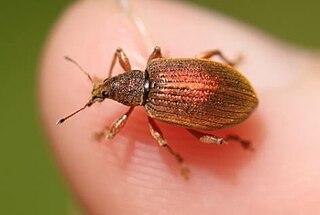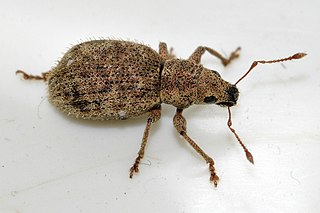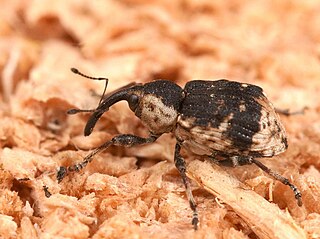
Weevils are beetles belonging to the superfamily Curculionoidea, known for their elongated snouts. They are usually small – less than 6 mm in length – and herbivorous. Approximately 97,000 species of weevils are known. They belong to several families, with most of them in the family Curculionidae. It also includes bark beetles, which while morphologically dissimilar to other weevils in lacking the distinctive snout, is a subfamily of Curculionidae. Some other beetles, although not closely related, bear the name "weevil", such as the biscuit weevil, which belongs to the family Ptinidae.

Hadramphus, commonly known as knobbled weevils, is a genus of flightless molytine weevils from the family Curculionidae. It is endemic to New Zealand and consists of four species.

Scolytus schevyrewi, the banded elm bark beetle, is a 3–4 mm long elm bark beetle species in the genus Scolytus native from Asia and accidentally introduced to North America. It is a vector of the Dutch elm disease, caused by the Ascomycota Ophiostoma ulmi and Ophiostoma novo-ulmi. In North America, it is displacing both the native elm bark beetle and the previously introduced smaller European elm bark beetle, which are becoming less common in their range with the expansion of S. schevyrewi.

Sitona sulcifrons is a species of weevil native to Europe.

Polydrusus mollis is a species of weevil native to Europe.

Polydrusus cervinus is a species of weevil native to Europe.

Sciaphilus asperatus is a species of weevil native to Europe. Larvae develop in spring and summer, as this beetle typically overwinters in its adult stage. Females lay between 450 and 700 eggs in the wild.

Sitona hispidulus is a species of weevil native to Europe and introduced to Asia and North America.

Otiorhynchus singularis is a species of weevil native to Europe.

Phyllobius viridiaeris is a species of weevil native to Europe.

Liparus coronatus is a species of beetles belonging to the family Curculionidae.

Dryocoetes autographus is a species of weevil native to Europe.

Hylesinus fraxini is a species of weevil native to Europe.

Dryocoetes villosus is a species of weevil native to Europe.

Orthotomicus laricis, commonly known as the lesser larch bark beetle, is a species of weevil native to Europe.

Pityogenes bidentatus is a species of bark beetle native to Europe.

Trypodendron domesticum is a species of weevil native to Europe.

Grypus equiseti, known by the common name horsetail weevil, is a species of weevil native to Europe. It feeds on Equisetum arvense and Equisetum palustre plants. It has been introduced to New Zealand to control Equisetum arvense, which is an invasive species there.

Notaris acridulus is a species of weevil native to Europe.

Tournotaris bimaculatus is a species of weevil native to Europe.


















